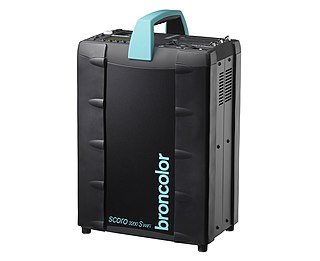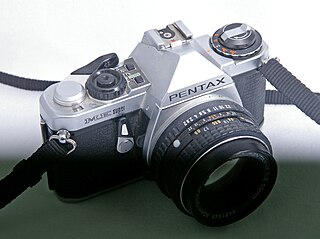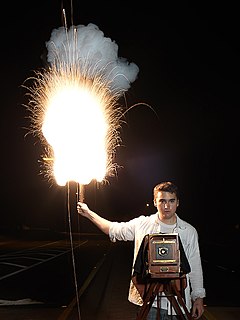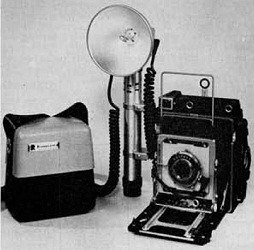 W
WPhotographic lighting is the illumination of scenes to be photographed. A photograph simply records patterns of light, color, and shade; lighting is all-important in controlling the image. Illumination is desired to give an accurate rendition of the scene. In other cases the direction, brightness, and color of light are manipulated for effect. Lighting is particularly important for monochrome photography, where there is no color information, only the interplay of highlights and shadows. Lighting and exposure are used to create effects such as low-key and high-key.
 W
WAn air-gap flash is a photographic light source capable of producing sub-microsecond light flashes, allowing for (ultra) high-speed photography. This is achieved by a high-voltage electric discharge between two electrodes over the surface of a quartz tube. The distance between the electrodes is such that a spontaneous discharge does not occur. To start the discharge a high-voltage pulse is applied on an electrode inside the quartz tube.
 W
WA battery–capacitor flash is a flash photography system used with flashbulbs. Instead of relying directly on the current pulse ability of a battery to directly fire a flashbulb, a battery is used to charge a capacitor that is then discharged through the flashbulb. BC flash units use 5.6V, 15V, or 22½V batteries.
 W
WA beauty dish is a photographic lighting device that uses a parabolic reflector to distribute light towards a focal point. The light created is between that of a direct flash and a softbox, giving the image a wrapped, contrasted look, which adds a more dramatic effect.
 W
WBowens International was founded as Bowens Camera Service Company, a London based camera repair company, in 1923 which by the 1950s had grown to be one of the largest in Europe. In 1963, the name Bowens International LTD. was registered. In June 2016 a German investment firm AURELIUS, bought Bowens and the following year in July 2017, AURELIUS closed down the company, discontinuing all further operations.
 W
WBron Elektronik is a manufacturer of flash equipment for photography and videography. It is located in Allschwil in Switzerland. Bron manufactures the broncolor lines of strobes. The broncolor line includes studio lighting systems with separate power packs and heads, as well as monolights. Both lines include light modifiers. The Focal Encyclopedia of Photography describes broncolor as "the leading Swiss manufacturer" of generator flash systems.
 W
WA flash is a device used in photography producing a flash of artificial light at a color temperature of about 5500 K to help illuminate a scene. A major purpose of a flash is to illuminate a dark scene. Other uses are capturing quickly moving objects or changing the quality of light. Flash refers either to the flash of light itself or to the electronic flash unit discharging the light. Most current flash units are electronic, having evolved from single-use flashbulbs and flammable powders. Modern cameras often activate flash units automatically.
 W
WIn photography, flash synchronization or flash sync is the synchronizing the firing of a photographic flash with the opening of the shutter admitting light to photographic film or electronic image sensor.
 W
WThe electric flash-lamp uses electric current to start flash powder burning, to provide a brief sudden burst of bright light. It was principally used for flash photography in the early 20th century but had other uses as well. Previously, photographers' flash powder, introduced in 1887 by Adolf Miethe and Johannes Gaedicke, had to be ignited manually, exposing the user to greater risk.
 W
WA gobo is an object placed inside or in front of a light source to control the shape of the emitted light and its shadow.
 W
WWhen setting photoflash exposures, the guide number (GN) of photoflash devices is a measure photographers can use to calculate either the required f‑stop for any given flash-to-subject distance, or the required distance for any given f‑stop. To solve for either of these two variables, one merely divides a device's guide number by the other.
 W
WThe PocketWizard is a wireless radio triggering system for off-camera lighting developed in the late 1990s, by LPA Design, an American company based in South Burlington, Vermont.
 W
WProfoto is a Swedish company that develops photographic flashes and other light shaping tools for professional photographers.
 W
WIn photography and cinematography, a reflector is an improvised or specialised reflective surface used to redirect light towards a given subject or scene.
 W
WRembrandt lighting is a standard lighting technique that is used in studio portrait photography and cinematography. It can be achieved using one light and a reflector, or two lights, and is popular because it is capable of producing images which appear both natural and compelling with a minimum of equipment. Rembrandt lighting is characterized by an illuminated triangle under the eye of the subject on the less illuminated side of the face. It is named for the Dutch painter Rembrandt, who occasionally used this type of lighting.
 W
WA ring flash is a circular photographic electronic flash that fits around a camera lens. Unlike point light sources, a ring flash provides even illumination with few shadows visible in the resulting photographs because the origin of the light is very close to the optical axis of the lens. It was invented by Lester A. Dine in 1952 for use in dental photography, but now is commonly used in applications such as macro, portrait and fashion photography.
 W
WIn photography, a snoot is a tube or similar object that fits over a studio light or portable flash and allows the photographer to control the direction and radius of the light beam. These may be conical, cylindrical, or rectangular in shape. Snoots can isolate a subject when using a flash. They help by stopping "light spill", or when lighting falls in a larger footprint than intended.
 W
WA soft box is a type of photographic lighting device, one of a number of photographic soft light devices. All the various soft light types create even and diffused light by transmitting light through some scattering material, or by reflecting light off a second surface to diffuse the light. The best known form of reflective source is the umbrella light, where the light from the bulb is "bounced" off the inside of a metalized umbrella to create an indirect "soft" light.
 W
WHard and soft light are different types of lighting that are commonly used in photography and filmmaking. Soft light is light that tends to "wrap" around objects, projecting diffused shadows with soft edges. Soft light comes from a light source that is large relative to the subject, whereas hard light from one that is small relative to the subject.
 W
WStroboflash is the name of one of the earliest commercially successful portable dry cell battery powered electronic flashes produced.
 W
WThree-point lighting is a standard method used in visual media such as theatre, video, film, still photography and computer-generated imagery. By using three separate positions, the photographer can illuminate the shot's subject however desired, while also controlling the shading and shadows produced by direct lighting.